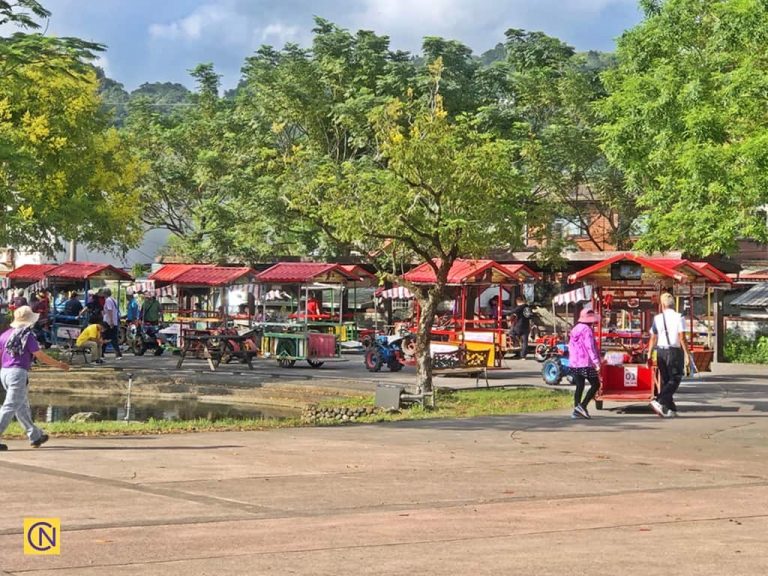Located in Yuanshan Township in northeastern Taiwan’s Yilan County, Neicheng (內城) was a quiet farm village. However, Neicheng Community Development Association’s novel ideas have transformed this quaint village into an agricultural leisure area featuring LOHAS (Lifestyles of Health and Sustainability) activities.
For more exciting images of LOHAS activities in Taiwan’s Yilan County, please watch the following video:
LOHAS activities
The main attraction of this agricultural leisure area is a tour by Tie Niu Li Aka (a single-axle tractor or motorized iron ox cart 鐵牛力阿卡). Visitors can ride this manned iron ox cart to explore various interesting sites in this area via different routes.

The Community Development Association offers a variety of programs to allow visitors to take in the beautiful vistas of the surrounding fields, enjoy the community’s traditional culture, explore the ancient trails, and soak their feet in bubbling cold spring water.

Moreover, visitors can also participate in fun DIY activities, including making handmade natural soaps, herbal cakes, red tortoise cakes, etc.
History
Necheng used to be an agricultural community where oxen were used to work the fields. However, with industrialization, oxen were gradually replaced by motorized tractors and other mechanized farm equipment in the 1960s.

To promote tourism and improve local farmers’ living standards, the Neicheng Community Development Association chairman and other regional administrators came up with the idea of transforming the old motorized tractors into sightseeing carts in 2007.
Tie Niu Li Aka (鐵牛力阿卡)
Tie Niu (iron ox carts, 鐵牛) means tractors. Taiwan farmers started to use the first generation of motorized tractors made by the Kubota Corporation in Japan to replace oxen in the 1960s. Nonetheless, those tractors were replaced by more sophisticated tractors in the 1980s.
Li Aka, also called Liakhah, (力阿卡) was initially a Japanese word originating from “real car” in English. It means a two-wheeled cart pulled by humans.
In 2007, the Neicheng Community Development Association chairman and another farmer collected six old tractors and combined each of them with a hand-pulled two-wheeled cart. These remodeled carts are called “Tie Niu Li Aka (motorized iron ox carts).” Currently, there are about 40 remodeled iron ox carts in the community, and they are used to transport tourists for pleasure to promote tourism in the community.

These tractors transport visitors to various scenic spots around this agricultural leisure area. Each can pull a trailer and has enough room for six passengers. It is driven by a farmer who acts as a tour guide, running through a set route between picturesque rice fields.
Qiang Zai Lian Pi (羌仔連埤)
Qiang Zai Lian Pi is a spring park with picturesque ponds and carbon dioxide cold springs. “Qiang Zai” means Formosan reeve’s muntjac (山羌 — a small Asian deer), while “Lian Pi” stands for two connected ponds. Nestled at the foot of the Snowy Mountain Range, these two ponds are where Formosan Reeves’ muntjac usually drink water when there are no people around. Therefore, it is so named.

A pipeline connects the two ponds. The water in one of the ponds looks clear, while the water in the other pond is deep blue and is covered by duckweed on the surface due to eutrophication.

The cold spring water comes out of the ground constantly. It is clear and clean and remains at about 20°C year-round. So this spring park stream is a popular foot-soaking location year-round.
Yi Yong Ancient Trail (隘勇古道)
The Yi Yong Ancient Trail was first constructed during the Qing Dynasty for transporting timber and agricultural products. It was renovated during the Japanese colonial period (1895-1945) mainly for security purposes in 1903.

The 1.2-Km ancient trail is a family-friendly hiking path. Starting at the Qiang Zai Lian Pi Spring Park, the old trail wanders up and down to the Bizaitou Park in the Dahu Scenic Area. Visitors can also gaze down over the beautiful Dahu Scenic Area.
The Tree Deity (大樹公)
The Tree Deity, also known as Tai-chhiu-kong, is over 300 years old. With a circumference of about 5.5 meters (18 ft), the canopy of the giant tree covers an area of about 450 square meters (4,844 square feet).

The local government has listed this sacred tree as one of the precious old trees of Yilan County. Legend has it that to ensure being blessed, descendants of the first settlers from mainland China tended to take their children to worship the Tree Deity and become the Tree Deity’s adopted child. It is also said that there is still an old incense burner inside the trunk of this giant tree.
Bubbling Crab (螃蟹冒泡) Cold Spring Park
Featuring bubbles emerging on the cold spring water’s surface like crabs blowing bubbles, this unique cold spring park was constructed in the Dahu Agricultural Leisure Area in 2006.

Visitors are often intrigued by the bubbles popping up from the crevices in the sand, measuring a diameter of about 10 cm (3.9 inches) each. There is no admission fee for this exciting attraction, where the pools, bathrooms, and showers are immaculate.

The temperature of the cold spring water hovers at a constant of 20°C. Visitors can soak their feet or swim in one of the three pools year-round.
Follow us on Twitter, Facebook, or Pinterest

